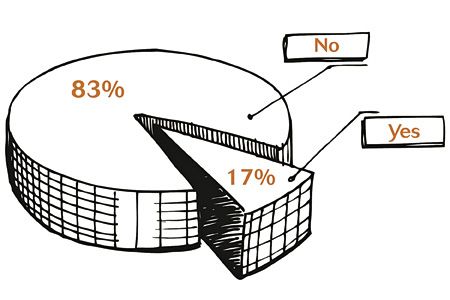A little help, please?
Despite evidence of widespread psychological distress in the veterinary field, a VHMA study shows very few hospitals offer Employee Assistance Programs.
Because what happens at home doesn't always stay at home, many large companies offer Employee Assistance Programs (EAPs)-voluntary and confidential support services for employees confronting challenges that may adversely affect their physical health, emotional wellbeing and job performance.
The benefits of EAPs aren't limited to corporations. These programs can provide valuable benefits to companies of all sizes, which is why a recent VHMA Insiders' Insight Monthly Management Survey sought to examine the prevalence of EAPs in veterinary practices and how they're being communicated and used.
EAPs-unlikely in practice?
Of the 210 managers who completed the survey, only 17 percent work in practices offering an EAP. The remaining 83 percent work in practices lacking both an EAP and plans for an EAP in the future.

Sixty-five percent of the practices surveyed rely on human resources to address such issues in the workplace.
Of the practices with an EAP, 71 percent report that third-party providers manage their programs. The list of providers includes ADP Total Service, Abby Glenn, Anthem, Aurora, AAHA, Blue Cross, Best Care, Cascade, Employee Resource Systems, Lincoln Financial, United Health, Paychex, Work Life Matters and YMCA. Sixteen percent of practices manage their EAP internally, and three percent have adopted hybrid programs that combine third-party providers with internal management.
Let's talk EAPs
The survey asked respondents from practices with an EAP to identify the ways employees receive information about the program they offer. They were given five choices and were instructed to select all that apply and to add additional comments, if necessary. The choices included
EAP presented to new hires
EAP is discussed with employee at a manager's discretion
Information about EAP contained in the employee manual
EAP information is communicated regularly
EAP is discussed during the annual benefit review.
Only six percent of the surveyed practices use all five strategies to promote their EAP to staff, and 11 percent rely on four of these strategies. Thirty-seven percent of practices use one of the strategies to communicate EAP information, and 36 percent say that the EAP isn't discussed until a manager suspects an employee needs help.
EAPs in practice
EAPs offer assistance for a wide range of issues. Family and marital problems top the list, along with emotional distress and alcohol and drug abuse. Issues not often addressed by such programs include crisis management, workplace violence and bullying and emergency preparedness.
Though 97 percent of managers from practices with an EAP consider the programs to be a vital employee benefit (around half say they enhance the work environment and reduce risks, and nearly 30 percent say they reduce staff turnover), only 41 percent think their employees feel the same way. Another 44 percent say they don't know what employees think, and 15 percent don't think employees view them favorably.

According to respondents, the most significant problem with EAPs is that employees are reluctant to use the services (52 percent). Another 18 percent believe EAPs are too costly, but nearly one-fourth are unable to list a downside.
What's the holdup?
More than 60 percent of managers from non-EAP practices say they don't understand the programs or where to find them. But considering how favorably they're viewed by managers and their perceived contributions to the work environment, EAPs are worth a look.
Practices considering offering an EAP or altering an existing program should keep these suggestions in mind:
To maintain confidentiality, use a third-party EAP service provider.
Make sure employees know the EAP is available and be clear about the services provided. Stress that all services are confidential.
Prepare supervisors and managers for their roles in the process. Yes, the service is confidential. And yes, employees are encouraged to seek the services themselves. But there are occasions when it's necessary for managers to facilitate the process.
If employee absenteeism is rampant and morale is low, it may be time to explore an EAP.